Unveiling the Mystery: How Long Does It Take to Get a Tan?
The allure of a sun-kissed glow is undeniable. Whether you crave a touch of bronzed radiance or a deeper tan, understanding the tanning process and the factors affecting it is crucial. This article delves into the science behind tanning, explores how long it typically takes to achieve your desired look, and equips you with safe tanning practices for a healthy summer glow.
Understanding the Tanning Process: Your Skin’s Cellular Reaction
Sun exposure triggers a complex biological response within your skin cells. Here’s a breakdown of the key players:
-
Melanin: The primary pigment responsible for skin and hair color. When exposed to ultraviolet (UV) radiation from the sun, melanocytes, specialized cells in the lower layer of your epidermis (skin’s outermost layer), produce more melanin. This melanin production is your body’s natural defense mechanism to shield the deeper skin layers from UV damage.
-
Types of Melanin: There are two main types of melanin:
- Pheomelanin: Responsible for reddish-brown tones, it provides some sun protection but less than the other type.
- Eumelanin: This darker pigment offers more significant sun protection and contributes to a deeper tan. The ratio of these two melanin types determines your natural skin tone and tanning potential.
Understanding your skin type and melanin production is essential for safe tanning practices.
Visible Results: The Timeline of Tanning
The time it takes to see a noticeable tan depends on several factors, but here’s a general timeline:
- Initial Exposure (First Few Days): After minimal sun exposure, you might experience mild skin reddening due to increased blood flow. This isn’t a tan but a sign of sunburn if it progresses to pain or blistering.
- The Tanning Phase (Days 3-7): Melanin production kicks in, and you might start to see a faint base tan developing. This early stage is crucial for building a foundation for a deeper tan without burning.
- Gradual Deepening (1-2 Weeks): With continued, controlled sun exposure, melanin production increases, and your tan will continue to deepen. Be patient and avoid excessive sun exposure, which can lead to burning and long-term skin damage.
Remember, these are just estimates. The actual time it takes to tan will vary depending on your individual factors.
Factors Affecting Tanning Speed: A Complex interplay
Several elements influence how quickly you tan:
- Skin Type: Fairer skin with less melanin production tans slower and burns more easily. People with darker skin tones naturally have more melanin and tan faster.
- Melanin Ratio: The ratio of pheomelanin to eumelanin in your skin plays a role. Those with more eumelanin will tan darker and faster.
- Sun Exposure Intensity: The intensity of UV radiation from the sun varies depending on the time of day, season, and altitude. Stronger UV rays lead to faster tanning but also increase sunburn risk.
- Skin Sensitivity: Certain medications and skin conditions can increase sun sensitivity and make tanning more difficult or even dangerous.
Safe Tanning Practices: Protecting Your Skin While Getting Your Glow
While a tan may be aesthetically pleasing, it’s crucial to prioritize sun safety. Here are essential tips for achieving a healthy tan:
- Sun Protection First: Apply a broad-spectrum sunscreen with SPF 30 or higher generously and reapply every two hours, or more often if swimming or sweating.
- Seek Shade: Especially during peak sun hours (10 am to 4 pm), seek shade and wear protective clothing like hats and sunglasses.
- Tan Gradually: Avoid prolonged sun exposure, especially in the beginning of the summer. Allow your skin time to adjust and build a base tan gradually.
- Hydration is Key: Staying hydrated helps your skin maintain its elasticity and overall health, promoting a healthier tan.
- Know Your Limits: Be mindful of your skin’s sensitivity and stop sun exposure if you experience any redness, burning, or pain.
Alternative Ways to Achieve a Glowing Look
If you have concerns about sun exposure or simply prefer a safer alternative, here are some options for a bronzed look:
- Self-Tanners: These lotions or creams provide a temporary tan without UV exposure. Choose a self-tanner that suits your skin tone and apply it according to the product instructions.
- Spray Tans: Professional spray tans offer a more even and temporary tan application. However, even with spray tans, sun protection is still essential.






More Stories
Where to Watch USMNT vs Jamaica National Football Team
How I Met My Monster
How Should a Ring Fit